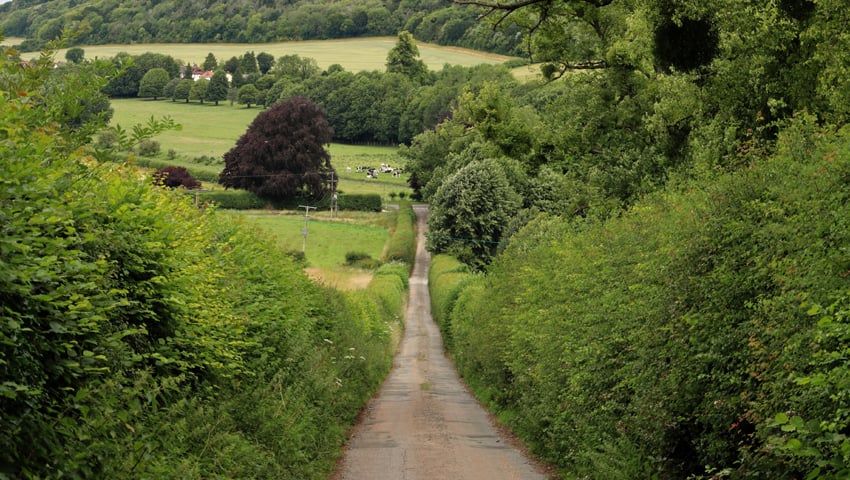Hedgerows have been at the heart of British farming for centuries. However, without the traditional lifecycle approach to management, their structural condition has been steadily declining. Last century, over half of our hedgerows were lost through incentivised removal; whilst recognition of their value has turned this around, it means those that remain are even more valuable, and the need for management advice is greater now than ever before.
The value of a healthy, connected hedgerow network cannot be overstated, especially in the face of the climate and biodiversity crises we’re experiencing. Hedgerows supply shade, shelter and diverse browse essential for high welfare, resilient livestock farming. They protect soil from erosion, encourage pollinators and offer natural pest control. They sequester carbon in their biomass and surrounding soils, and filter pollutants, preventing them reaching nearby water courses. Healthy hedgerows are a huge asset to farming.
Hedgerows are vital habitats for much of our native wildlife too, including rare hazel dormice, hedgehogs, and several bat and bird species. They’re safe navigational corridors, but also provide nesting sites, shelter and food. In fact, one study found over 2,000 species within an 85m stretch of hedge in Devon.
Healthy Hedgerows survey on the Land App
Healthy Hedgerows is a rapid hedgerow health-checking survey designed by People’s Trust for Endangered Species (PTES) based on the Adams Hedgerow Management Scale. Farmers and land managers answer six simple questions to determine the health of their hedgerows. The survey places each hedge into the hedgerow lifecycle and offers management advice for each hedgerow surveyed, which can then be collated to help create a farm-scale management plan.
Now, thanks to a new collaboration with the popular cloud-based mapping platform, Land App, farmers and land managers across the UK can record the condition of their hedgerows via PTES’ Healthy Hedgerows survey, which is available as part of Land App and Land App Mobile (Standard and Professional Subscription required).
The collaboration is part of a bigger update by Land App, which has introduced a range of surveys onto Land App Mobile for the first time, complementing the existing desktop mapping software and funding scheme templates. Offline functionality is now possible too, meaning users can undertake surveys of their land on the go, via Land App Mobile.
Sustainable Farming Incentive
The SFI hedgerow assessment action CHRW1 is a new approach from the government and is the first time farmers are paid (currently £5 per 100 metres per side per year) to undertake a hedgerow health-check of this kind. To do this, farmers based in England can now use the Healthy Hedgerows survey on Land App and Land App Mobile, which is based on PTES’ original survey recommended by Defra as the go-to tool for recording SFI hedgerow actions.
The aim of the government’s hedgerow assessment is to better understand the condition of the UK’s hedgerows with the aim to effectively plan how they can be managed to improve their condition. Crucially, once the Healthy Hedgerows survey is completed through the Land App, users can get free bespoke hedgerow management advice from PTES with the click of a button. This might be highlighting which hedges would benefit from rejuvenation, or which might be best suited to trimming incrementally higher and wider. Ultimately it will help farmers to create or adjust their farm-scale hedgerow management plans, ensuring the health and long-term survival of these iconic habitats as well as all the many species that call hedgerows home.
Hedge-laying
Environmental Scientist, Josie Muncaster, was introduced to hedge-laying three years ago and is keen to promote its importance.
She said, “Initially, I liked hedge-laying because it’s great fun, uses a variety of different tools requiring different levels of skill, and strength (billhooks, axes, saws), but I soon came to realise that managing a hedge through laying it on rotation is absolutely the best method for long term management of hedges as boundaries, for wildlife, the environment, people and agriculture.”
Muncaster identified the following benefits of hedge-laying:
- Provides a dense hedge with plenty of cover for mammals to travel, spaces for birds to nest, and food for predators
- Provides shelter for livestock (you’ll often see them choose the hedge, not the post and wire fence for shelter in poor weather)
- It sequesters carbon through lots of young growth after cutting on an old root system
- It rejuvenates the hedge, meaning that the same hedge can serve a purpose for a very long time (much longer than a fence can, and you don’t have to buy the materials)
- It provides some flood defence through its dense, but also leaky structure
- It enables the hedge to stay as a green screen for capturing pollution, and not become leggy
- Continuing to lay hedges keeps rural traditional skills and communities alive
- It looks fantastic!
